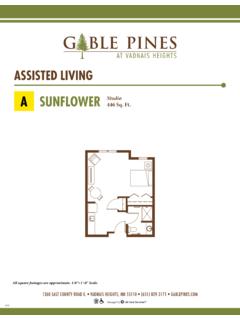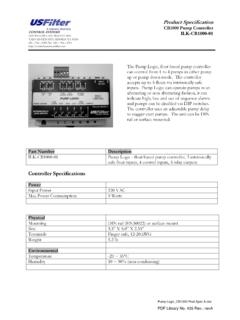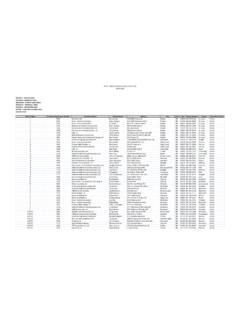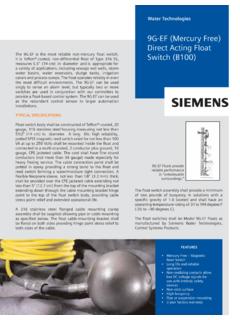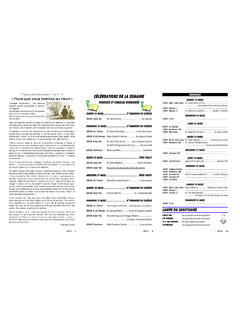Transcription of MATERIAL SAFETY DATA SHEET - kamarinc.com
1 Page 1 of 1 08-19-2014 804839PM MATERIAL SAFETY data SHEET _____ REVISION DATE: 08-19-2014 SUPERSEDES: 08-06-2014 SECTION 1: CHEMICAL PRODUCT AND COMPANY IDENTIFICATION COMPANY INFORMATION Fuller Company 1200 Willow Lake Boulevard Vadnais Heights, MN 55110 Phone: 888-423-8553 Medical Emergency Phone Number (24 Hours): 1-888-853-1758 Transport Emergency Phone Number (CHEMTREC): 1-800-424-9300 PRODUCT INFORMATION PRODUCT NUMBER: SC0639 PRODUCT DESCRIPTION: Solvent adhesive PRODUCT IDENTIFIER: 804839PM SECTION 2: HAZARDS IDENTIFICATION EMERGENCY OVERVIEW PHYSICAL STATE: Liquid COLOR: Amber ODOR: Solvent Extremely flammable. Can cause skin irritation. May cause allergic skin reaction. May cause an allergic respiratory reaction. Harmful if swallowed. POTENTIAL HEALTH EFFECTS BY ROUTE OF ENTRY EYE: Mild eye irritant.
2 SKIN: Can cause skin irritation. May cause allergic skin reaction. INHALATION: Can cause minor respiratory irritation. Long term overexposure to some resin acids (colophony) fumes may lead to respiratory sensitization. Inhalation of dusts produced during cutting, grinding or sanding of this product may cause irritation of the respiratory tract. Inhalation of vapors may cause loss of feeling and weakness in the hands and feet and loss of manual dexterity. Inhalation of high concentrations may result in central nervous system (CNS) effects such as dizziness, weakness, fatigue, nausea, headache, and lack of coordination. Methanol can cause central nervous system depression and overexposure can cause damage to the optic nerve resulting in visual impairment or blindness. This product contains one or more materials that may be hazardous when present as an airborne dust.
3 During normal handling of the product, the MATERIAL is encapsulated within the product and will not present an exposure risk. Once the product has reached its final state and is abraded or disturbed, dusting and exposure may occur. INGESTION: Ingestion is not an anticipated route of exposure. Harmful if swallowed. Irritating to mouth, throat, and stomach. LONG-TERM (CHRONIC) HEALTH EFFECTS REPRODUCTIVE: Contains a substance that is a possible reproductive hazard based on animal studies. TARGET ORGAN(S): Central nervous system Peripheral nervous system Lungs Skin Eyes REGULATED CARCINOGEN STATUS: Unless noted below, this product does not contain regulated levels of NTP, IARC, ACGIH, or OSHA listed carcinogens. Page 2 of 2 08-19-2014 804839PM MATERIAL SAFETY data SHEET _____ EXISTING HEALTH CONDITIONS AFFECTED BY EXPOSURE: Skin disease including eczema and sensitization; Lung disease; Eye disease SECTION 3: COMPOSITION/INFORMATION ON INGREDIENTS Chemical Name CAS # PERCENT Hexane, n 110-54-3 30 - 50 Wood rosin 8050-09-7 5 - 10 Mineral oil 5 - 10 Methylcyclopentane 96-37-7 1 - 5 3-Methylpentane 96-14-0 1 - 5 Methylpentane, 2- 107-83-5 1 - 5 Calcium carbonate 471-34-1 1 - 5 Methyl alcohol 67-56-1 - 1 Unlisted ingredients are not 'hazardous' per the Occupational SAFETY and Health Administration Hazard Communication Standard (29 CFR ) and/or are not found on the Canadian Workplace Hazardous Materials Information System ingredient disclosure list.
4 See Section 8 for exposure limit guidelines. SECTION 4: FIRST AID MEASURES IF IN EYES: None expected to be needed, however, use an eye wash to remove a chemical from your eye regardless of the level of hazard. IF ON SKIN: Wash with soap and water. Get medical attention if irritation develops or persists. IF VAPORS INHALED: Remove to fresh air. Call a physician if symptoms persist. IF SWALLOWED: Do not induce vomiting. Seek medical attention immediately. Drink two glasses of water or milk to dilute. Do not give anything by mouth to an unconscious person. Induced vomiting may lead to aspiration of the MATERIAL into the lungs potentially causing chemical pneumonitis that may be fatal. SECTION 5: FIRE FIGHTING MEASURES FLASH POINT: -18C; 0F TCC AUTOIGNITION TEMPERATURE: Not established LOWER EXPLOSIVE LIMIT (% in air): Not established UPPER EXPLOSIVE LIMIT (% in air): Not established EXTINGUISHING MEDIA: Use water spray, foam, dry chemical or carbon dioxide.
5 UNUSUAL FIRE AND EXPLOSION HAZARDS: Vapors are heavier than air and can travel to a source of ignition and flash back. SPECIAL FIRE FIGHTING INSTRUCTIONS: Persons exposed to products of combustion should wear self-contained breathing apparatus and full protective equipment. HAZARDOUS COMBUSTION PRODUCTS: Carbon dioxide, Carbon monoxide SECTION 6: ACCIDENTAL RELEASE MEASURES SPECIAL PROTECTION: No health effects expected from the cleanup of this MATERIAL if contact can be avoided. Follow personal protective equipment recommendations found in Section 8 of this MSDS. Evaporation of volatile substances can lead to the displacement of air creating an environment that can cause asphyxiation. CLEAN-UP: Dike if necessary, contain spill with inert absorbent and transfer to containers for disposal. Keep spilled product out of sewers, watersheds, or water Page 3 of 3 08-19-2014 804839PM MATERIAL SAFETY data SHEET _____ systems.
6 Shut off ignition sources; including electrical equipment and flames. Do not allow smoking in the area. Transport Emergency Phone Number (CHEMTREC): 1-800-424-9300 SECTION 7: HANDLING AND STORAGE Handling: Mildly irritating MATERIAL . Avoid unnecessary exposure. Keep away from heat, sparks and flame. Wash thoroughly after handling. Keep container closed. Emptied container retains vapor and product residue. Observe all labeled precautions until container is cleaned. Drums of this MATERIAL should be grounded when pouring. DO NOT CUT OR WELD ON OR NEAR THIS CONTAINER. Storage: Store in a cool, dry, ventilated location. Keep away from heat, sparks, flame and other sources of ignition. Keep container closed. Consult the Technical data SHEET for specific storage instructions. SECTION 8: EXPOSURE CONTROLS/PERSONAL PROTECTION EYE PROTECTION: Wear SAFETY glasses when handling this product.
7 SKIN PROTECTION: Avoid skin contact by wearing chemically resistant gloves. Skin absorption may potentially contribute to the overall exposure to this MATERIAL . Appropriate measures should be taken to prevent absorption so that the TLV is not invalidated. GLOVES: Nitrile RESPIRATORY PROTECTION: Respiratory protection may be required to avoid overexposure when handling this product. Use a respirator if general room ventilation is not available or sufficient to eliminate symptoms. NIOSH approved air purifying respirator with organic vapor cartridge. Respirators should be selected by and used following requirements found in OSHA's respirator standard (29 CFR ). VENTILATION: Use local exhaust ventilation or other engineering controls to minimize exposures. EXPOSURE LIMITS: Chemical Name ACGIH EXPOSURE LIMITS OSHA PEL Hexane, n 50 ppm TWA Skin absorption may potentially contribute to the overall exposure to this MATERIAL .
8 500 ppm TWA; 1800 mg/m3 TWA Wood rosin Not established Not established Mineral oil Not established 5 mg/m3 TWA (as mist) Methylcyclopentane Not established Not established 3-Methylpentane Not established Not established Methylpentane, 2- Not established Not established Calcium carbonate Not established 15 mg/m3 TWA (total dust); 5 mg/m3 TWA (respirable fraction) Page 4 of 4 08-19-2014 804839PM MATERIAL SAFETY data SHEET _____ Methyl alcohol 200 ppm TWA 250 ppm STEL Skin absorption may potentially contribute to the overall exposure to this MATERIAL . 200 ppm TWA; 260 mg/m3 TWA SECTION 9: PHYSICAL AND CHEMICAL PROPERTIES PHYSICAL STATE: Liquid COLOR: Amber ODOR: Solvent ODOR THRESHOLD: Not established WEIGHT PER GALLON (lbs.): SPECIFIC GRAVITY: SOLIDS (% by weight): pH: Not established FLASH POINT: -18C; 0F TCC BOILING POINT (deg.)
9 C): Not established FREEZING/MELTING POINT (deg. C): Not established VAPOR PRESSURE (mm Hg): Not established VAPOR DENSITY: Not established EVAPORATION RATE: Not established OCTANOL/WATER COEFFICIENT: Not established VOC, weight percent Not determined SECTION 10: STABILITY AND REACTIVITY STABILITY: Stable under normal conditions. CHEMICAL INCOMPATIBILITY: Strong oxidizing agents HAZARDOUS POLYMERIZATION: Will not occur. HAZARDOUS DECOMPOSITION PRODUCTS: Carbon monoxide, carbon dioxide SECTION 11: TOXICOLOGICAL INFORMATION COMPONENT LD50 ORAL LC50 INHALATION LD50 DERMAL Hexane, n Oral LD50 Rat = 28,710 mg/kg Inhalation LC50 Rat = 48,000 ppm/4H Dermal LD50 Rabbit 3,000 mg/kg Wood rosin Not established Mineral oil Oral LD50 Rat > 15,000 mg/kg Dermal LD50 Rabbit > 5,000 mg/kg Methylcyclopentane Not established 3-Methylpentane Not established Methylpentane, 2- Not established Calcium carbonate Oral LD50 Rat = 6450 mg/kg Methyl alcohol Oral LD50 Rat = 5628 mg/kg Inhalation LC50 Rat = 64,000 ppm/4H Dermal LD50 Rabbit = 15,000 mg/kg TOXICOLOGY SUMMARY: No additional health information available.
10 SECTION 12: ECOLOGICAL INFORMATION OVERVIEW: No ecological information available for this product. Page 5 of 5 08-19-2014 804839PM MATERIAL SAFETY data SHEET _____ SECTION 13: DISPOSAL CONSIDERATIONS This product meets the definition of hazardous waste under the EPA Hazardous Waste Regulations 40 CFR 261. It is ignitable waste class D001. Disposal via incineration is recommended. Consult your state, local, or provincial authorities for more restrictive requirements. LAND DISPOSAL RESTRICTIONS: Methanol SECTION 14: TRANSPORTATION INFORMATION Consult Bill of Lading for transportation information. DOT: UN1133, ADHESIVES, 3, II. IN CONTAINERS 30 LITERS ( GALLONS) OR LESS: UN1133, ADHESIVES, 3, III (FLASH POINT LESS THAN 23 C, VISCOSITY CONFORMS TO 49 CFR (B)) IATA: UN1133, ADHESIVES, 3, II. IN CONTAINERS 30 LITERS OR LESS: UN1133, ADHESIVES, 3, III (FLASH POINT LESS THAN 23 C, VISCOSITY CONFORMS TO IATA ) IMDG: UN1133, ADHESIVES, 3, II, FLASH POINT -18 C, EMS F-E, S-D.
